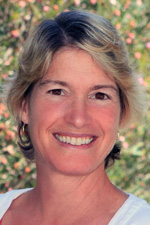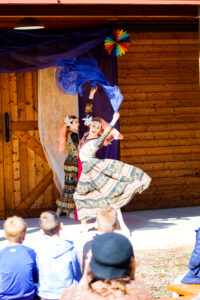
ENCINITAS, California — In recognition of the upcoming Purim celebration, the Hive at the Leichtag Commons, Coastal Roots Farm, and the Lipinsky Family San Diego Jewish Arts Festival melded their strengths to bring us a spirited retelling of the Purim Story.
“Shushan on the Farm” was performed twice on February 26 by a talented group of local actors, dancers, and musicians. As we gathered in the lovely, stone amphitheater, it was apparent that after three days of uncharacteristic torrential rain and record low temps, the young children and adults alike, were appreciative of the bright sunshine, even with the ocean breeze. Delightfully, some of the visitors were dressed in Purim costumes to enhance the merriment.
Using the verdant Coastal Roots Farm as a backdrop, the ancient tale unfolded at various stages around the farm. Our Shushan native tour guide, Habonalah (Rebecca Joy Fletcher) welcomed us to the Persian city and introduced us to the inhabitants. She gave us the quick backstory of how King Achashverosh (Jason Heil) was in search of a new queen after his previous bride was taken out of the picture. This seemed to have been shrouded in some mystery. We’d arrived just in time for a beauty pageant, from which the king would choose his new wife. Harbonalah invited some princesses from our audience to join the pageant, assuring them that they had a good chance at being selected for their beauty.

The San Diego Ballet, choreographed by Javier Velasco provided a beautiful entry to the program. Dancers Emily Banet, Rebekah Brannon, Tanika Hahn, and Jaqueline Lutz, each decked out in colorful scarves and harem costumes performed to the music of Yale Strom and Fred Benedetti, two masterful musicians, adored locally and internationally. Harbonalah ushered us from the ballet toward a field where we were introduced to Hadassah (Rebecca Myers) and her cousin Mordechai (Komi M. Gbeblewou). As they farmed and harvested, Mordechai tried to convince his cousin why she must enter the beauty pageant to become a spokeswoman and intermediary for the Jewish people of Shushan. Hadassah acquiesced and opted for the name Esther, as it was less identifiable. (The root letters of the name mean to hide or conceal. Clever!) Though she struggled with masking her Jewishness, she saw that it was necessary to save the Jews.
Our next highly entertaining stop brought us to the palace where we eavesdropped on a conversation between the egomaniacal King Achashverosh and his sycophantic sidekick, Haman (Jason Maddy) BOO! In this delightfully penned scene, we learned that Haman was lobbying to have the King decree the decimation of all of the Jews. He explained to the king that Mordechai the Jew would not bow down to him, and by extension, would not bow down to the king, ergo Mordechai, and by extension, ALL Jews should be killed. The king ultimately followed this line of thinking and agreed. At this point our tour guide, Harbonalah became a bit anxious. It seemed things were rotten in the state of Shushan. However, she shared that her mother always told her, when you’re feeling worried or anxious you should do something nice for someone else. And with this instruction, we were escorted over to a booth for making some really creative mishloach manot baskets, which included chocolate kisses and fresh herbs from the farm! Clearly, this was a hit with both adults and children in our audience. Harbonalah was eager to get us to the palace to meet the new queen, but en route, we were deterred.
Approaching a tree, a beautiful, forlorn woman asked us for just a moment of our time. We soon learned that this was Vashti, the first queen. She told us a chilling tale about how she’d been married to the king at the age of ten, and due to her fear, had lost her voice. She had not spoken to the king until she was summoned to dance naked for the king and his men after a ten-day feast. She was brought before him and found her voice. “No!” she declared. She refused and was beheaded. Perhaps a bit too graphic and grisly, but true to the megillah, Vashti (Kate Rose Reynolds) told us that her head was served to the king on a platter. Yikes! I hope the kids in the audience weren’t scarred for life. At this point, our tour guide was obviously on edge and wanted us to have a much better impression of her hometown. So with apparent trepidation, she bade us follow her to the palace, where Esther had been preparing a feast for the king, with the intention of revealing her identity and begging for his clemency toward the Jews.
The audience held our collective breath as we watched Esther gather her wits and courage and tell King Achashverosh that she and her people should be spared and that Haman (BOO!) and his sons should be put to death for their evil plotting. The king listened to the wise and altruistic Hadassah and granted her wish.
And with that Harbonalah reminded us of the old adage, well-known to Jews: “We fought, we won, let’s eat!” And with that, the group was led to a tent where we were offered hamantaschen, libations, and other sweet treats to celebrate our triumph. A face painting booth was offered by Gardenia’s Faces.
This retelling was truly fun and festive. The credit for creating the script goes to Ali Viterbi, Salomon Maya, Rebecca Joy Fletcher, and Toddy Salovey.
Salovey also directed the entertaining play and culled an amazing cast.
Eva Trieger is a freelance writer specializing in the arts. She may be contacted via eva.trieger@sdjewishworld.com
A lovely, short feature story. Thank you!